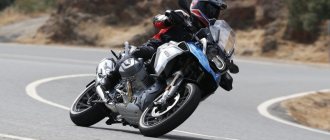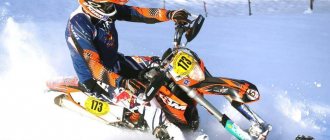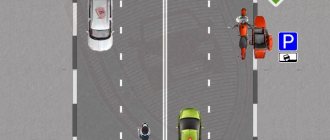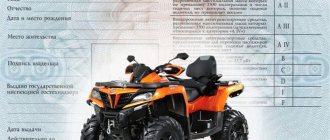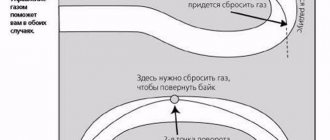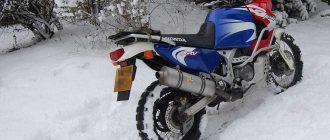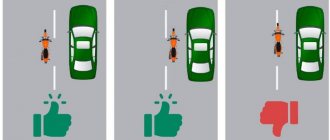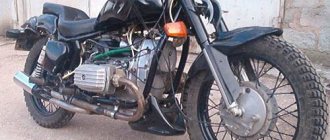An undoubted argument in favor of motorcycle life is the maximum sense of reality while traveling: no roll cage, no air conditioning, so if it’s hot, you feel it, and if it’s raining, you get wet to the skin. In fact, driving in bad weather is the same counterargument as a plus sign for the reality of sensations on a fine day.
What should you consider when driving in the rain?
- Bad visibility. You see poorly and they see you even worse
- Poor tire adhesion to the road surface
1. Avoid driving immediately after rain
Roads are at their slipperiest when it starts to rain, especially if it hasn't drizzled in a while. The initial 15 minutes of rain are the worst. This is because oil, fluid, fuel, and dirt are deposited on the roadway surface over time. When it rains, these deposits mix with the water and remain on the road surface, making driving more dangerous. These deposits usually spread out and are also removed after 15 minutes - if you are on the roadway when it starts to sink, consider stopping and waiting 15 minutes . If you can't postpone your trip, at least be vigilant to ensure that sections of the roadway are particularly smooth during this time.
prepare your motorcycle
Tires
Evaluate PSI and tread before riding. Make sure their pressure is correct for your motorcycle. A heavy downpour is not the time to try your luck with an airy or flat tire .
Your tires should be prepared for direct water, when water remains in the media, walking on the tires will dissipate it - very common, extra tread less water in the media and also more traction .
brakes
Your brake pads should have enough braking material to stop as needed in wet weather.
Gas level
Make sure you have plenty of gasoline in the storage tank before driving in the rain and make sure there are no leaks . Running out of gas during a tornado or rainstorm is not suitable. An oil leak can create a serious safety problem: when oil mixes with water, it becomes a recipe for unsafe and risky problems that can end your ride prematurely.
Headlights and reflectors
Make sure all headlights, taillights and flashers are working properly and that no bulbs go out. Make sure all reflectors are intact - they will definitely work during periods of poor visibility.
selecting the correct gear
A raincoat designed for motorcyclists is an "essential" for the rider. And a rain jacket or all-weather riding jacket and trousers and waterproof gloves , as well as boots , are essential if you're likely to be riding long distances or even traveling.
When it comes to clothing, there is a wide range of waterproof alternatives. One of the most important aspects of motorcycle clothing is making sure it all fits together well .
A layer that is also large will allow water to penetrate inside. Baggy gloves allow water to run down the sleeves into them, and large boots will certainly do the same.
All this means that you will feel uncomfortable on a wet road, and if you get wet, you will feel cold . This is the chill of the wind to which we have opened ourselves. When you are cold, you will not make good decisions as it will certainly hinder your functional skills and awareness. The cold is a distraction. As a result, it is important that your clothing is not only waterproof, but also fits well.
Rain conditions are notoriously dark as well as depressing, and it's easy to mix them up right on the road. This makes it even harder than usual for cars to see you. Wear intense gear for much better exposure. Do it yourself with intense shades as well as reflective surface areas.
Use a waterproof bag or pocket for anything that could be damaged by water , such as your cell phone or electronic devices. Even cases that are advertised as waterproof can cause loss if water gets into the case. It's much better to play it safe than to be sorry.
Waterproof Fodsports Intercom with Bluetooth
Search for dry road sections
Motorcycles feel more confident on dry asphalt, so you should strive to move on it. After the rain stops, due to the intense traffic of cars, dry zones form in the area where the tires are adjacent to the road or in the middle of the lane. The last option is the result of the movement of air masses by trucks.
But it should be taken into account that trucks and long vehicles create a large amount of water dust, so you should not drive too close to them. You need to be especially careful when overtaking a large truck: the spray from the giant wheels is blinding.
anti-fog treatments
Fogging occurs when there is humidity and a difference in temperature levels on either side of objects. Consequently, rain, as well as airborne moisture, can cause your safety glasses, helmet visor, and windshield to fog during a rainstorm. When using a helmet, try to keep the visor open for air flow and to prevent it from fogging up. Never ever try to ride with a foggy helmet . It is best to use anti-fog agents. If you encounter a situation where fogging is imminent, stop until the problems are no longer a problem .
5. Slow and extra braking distance
Slow down. If you're driving in the rain, you need to slow down. Allow extra stopping distance between you and others while driving. In wet weather, the distance to escape increases, so increase the buffer zone between your bike and other vehicles. Also, remember that you will need extra range to stop when approaching an intersection. Dry pavement is ideal for stopping, but wet roads significantly increase the distance you can travel.
So slow down So as not to take risks and offer yourself (as well as others) enough time to make decisions.
The right equipment
As soon as the issue with tires is resolved, a suitable model “for water” is selected, you need to pay attention to preparing the body. This means investing in some decent rain gear. Getting wet on a motorcycle means quickly freezing, which is dangerous for your health. When a person is cold, his physical and mental abilities decrease.
There are two types of rain gear: what a biker puts on when he thinks it might rain, and what actually keeps him out of the rain. Waterproof textiles and leather – what to choose? Experience has shown that the first material does not protect against moisture.
The Oxford Montreal 3.0 jacket and Montreal 2.0 trousers are gear that protects against rain. These are comfortable, everyday items you can rely on. They will really keep water out throughout the entire trip. In fact, a high-quality kit like the Aerostich Roadcrafter R-3 can withstand a downpour for quite a long time, but will eventually get wet if you travel in the rain all day.
For bad weather conditions, Old Certain School Rain Definite gear is your best bet. It's an ugly, plastic-like substance that goes over regular gear but provides waterproofing. It doesn't provide natural ventilation and doesn't look cool, but it effectively protects against moisture. After testing gear from Richie, Held, Weiss and Furigan, Chris decided on the Dens-Dust and D-Custa jacket. This is the equipment you need to be well prepared for any weather conditions.
braking
Next to alertness is braking: the faster you see hazards and edges, the sooner and much more effectively you can use the brakes.
The key to stopping effectively in wet conditions is to do it effectively and gradually. This will definitely prevent your tires from going haywire, which is an integral part of safe driving in wet weather.
If you need to hit the brakes hard, pump them to stop hydroplaning. Do not simply apply the front brakes as this may cause the front wheel to blow out.
Apply more rear brake than usual . If your front wheel starts to slip, you have a problem. If you have a rear wheel, you can always fix it.
Attention, vigilance, caution
Every effort must be made to avoid erratic movements and sudden stops. The key to achieving this is keeping your attention on the road. The important thing here is to make every effort to anticipate problems and come up with ways to deal with them. In other words, bikers should ride as advised by RoSPA - the Royal Society for the Prevention of Accidents, one of several UK organizations that teach safe riding techniques.
Poor visibility typical of driving in the rain makes it difficult to scan the road, so you need to slow down. A biker should not ride faster than he can react. The advice has a double benefit: it will increase the chances of seeing an obstacle ahead, and also the motorcyclist will not be blinded by the moisture created by the wheels of cars ahead of the bike.
keep calm
Maintain a calm stance with your back supported. The tightening of muscle tissue will cause tension in your mind and body and may also make you panic about the change in scenario. If you're tense and immobile on your bike, you'll struggle to ride efficiently and that's just one of the secrets to riding safely in the rain.
Try to keep your muscle tissues relaxed and maintain normal posture. Don't sit as straight and also relax - this way, any loss of grip will certainly not result in sudden movements of the entire body that will significantly affect your handlebars as well as the handling of the bike. As with suspension, if you're dangling, any unexpected slips, slides, and jerks are bound to be accounted for.
Gain a physical skill
The expert recommends taking an off-road motorcycle riding course, even if the biker prefers to ride on smooth asphalt. This will help you become more confident and remain calm in various driving situations.
One of the fundamental points in such courses is learning the correct movement of the body, shifting the center of gravity. Most often, the “right place” is closer to the ground. This can be as simple as moving your body closer to the tank or placing your weight on the pegs. However, you should not change the style radically, so that it does not negatively affect the comfort of travel.
In general, a rainstorm is not the best situation to try something new on the move. You just need to remember how and where to position your body - this will help when maneuvering. The most important thing is not to be too tense or relaxed. Nerves can make you tense, but you can't let them take over.
8. Beware of road hazards
Shiny smooth surfaces
Markings of the roadway , manhole covers , and even sections of the road will certainly make driving on a wet road much more dangerous. It's simple physics - any type of surface that isn't porous will certainly be slippery to ride on since water falling on it has nowhere to go and also sits on the surface.
Try to avoid riding on them as high as possible, and if slippery surfaces are unavoidable, try to ride them in a straight line , prevent them from braking, and keep the bike as upright as possible.
Pits and puddles
Watch out for puddles and don't drive through them . Driving around pools can create dirt and rocks that hit your canopy, making it impossible to see. Puddles can mask potholes as well as damage to the roadway surface. Plus, you never know how deep a crack or pool is underwater. Avoid motorcycle damage or breakdown by preventing it.
Oil residue
Never drive with oil spills on the road. One of the benefits of driving on a wet road is that it can often be further identified as the oil gives off a rainbow sheen to the section of road. If a spill is unavoidable, safely minimize speed as much as possible to avoid slipping.
Be observant . The sooner you see puddles, unsafe roadway markings and oil spills, the more time you have to change and reduce their impact.
Driving a motorcycle in the rain
“He who doesn’t drive in the rain doesn’t drive”Don't stay at home because of a bad weather forecast. With the appropriate motorcycle equipment, a working motorcycle and a good mood, riding a bike is always interesting, regardless of whether the sun is shining or raining. Get out of the house and ride for fun! Whether you ride your motorcycle every day or only ride once a week, sooner or later you will have to ride in the rain. Honda Australia Rider Training (Melbourne and Sydney) has produced recommendations to improve the safety of motorcyclists who have to ride on wet roads. (We included three articles in this material.)
BRAKING
Analysis of accident data shows that in 85% of cases, motorcyclists brake incorrectly. In other words, they either fail to use the brakes at all, brake too hard (and lock up the wheels), or underuse or overuse the front or rear brakes. Thus, it appears that very few motorcyclists regularly practice emergency braking on dry surfaces, let alone wet ones. Waiting for the next emergency to arise so you can practice emergency braking is not the best approach. The most common question that comes up is “How hard can I brake on wet roads?” The answer is simple: try it! The best way to improve your braking is practice. This doesn't mean you have to wait for it to rain when you're riding your motorcycle home from work during rush hour. Start improving your braking on dry roads, at a speed you feel comfortable with. Take the HART (Honda Australia Rider Training) course to improve your riding skills. Once you have practiced and become more confident, gradually increase your speed and apply braking. Once you're comfortable braking in the dry, try braking in the wet, again starting at a speed you feel comfortable riding the bike at and then gradually increasing your speed as your basic skills improve.
CLUTCH
Many motorcyclists are concerned about tire grip on wet roads, especially when cornering. Naturally, the degree of grip decreases on a wet road as opposed to a dry surface. The solution in this situation is to limit your tire grip requirements. Drive the bike more gently, don't change anything too suddenly, i.e. Do not suddenly accelerate, brake or change direction. In order to improve traction, the rider can change his position in the saddle. If the rider shifts their body position/weight to the inside of the turn, the bike will lean less into the road, so the tires will have more contact area and therefore more traction. A prime example of how a motorcyclist can use saddle position to improve tire grip are Grand Prix riders (although they do shift their weight in extreme conditions). On wet roads, tread depth becomes very important. The deeper the tread, the easier it is for tires to prevent water from accumulating, so worn tires will have less traction in the rain. There is a myth that lowering the tire pressure helps them warm up faster and increases the contact surface area with the road, but this is a misconception. The recommended level of pressure promotes traction as the tire maintains the correct shape and the tread remains loose and not pinched, allowing for better water shedding.
BRAKING DISTANCES
Who will stop faster in the rain - a motorist or a motorcyclist? As a rule, a motorist will stop faster. The car has the advantage of four wheels, so the total contact area of the tires will be higher. If a motorist locks the wheels in a panic situation, the car usually just starts to slide and skid. The motorcycle in such a situation tends to fall onto the road. When you drive on a wet road, increase your distance from other vehicles. If you make a mistake and lock a wheel while braking, you will have more distance to release the brakes and brake again.
VISIBILITY
During rain, especially if it is heavy, visibility and visibility of the road ahead deteriorates. If your helmet glass is clean, water will drain off it more easily. When you check the situation on the road, turning around, water flows faster from the helmet glass. Having a clear view of the road ahead is one of the most difficult tasks a motorcyclist has to perform, especially in the rain. The further you view the road, the more time you have to react to changes in traffic conditions ahead.
APPROPRIATE MOTORCYCLE EQUIPMENT
If you get caught in the rain and get wet, you will soon start to feel cold. The colder you get, the more sensation you lose, especially in your fingers and toes. In order for the machine to work effectively, it is very important to feel the motorcycle when braking, it is also important to feel the clutch and gearbox. In addition, when you are cold, you lose overall concentration. Buy some decent motorcycle gear that protects you from the rain. The rain cover is quite compact when folded and fits into a rear case, bag or trunk under the saddle. If you carry a set of protective clothing with you when it rains, you will not only be more confident in riding your motorcycle, but the ride will be much more enjoyable.
DON'T STAY AT HOME!
Now that we have given some recommendations for driving in the rain, we need to put them into practice. Don't stay at home because of a bad weather forecast. With the appropriate motorcycle equipment, a working motorcycle and a good mood, riding a bike is always interesting, regardless of whether the sun is shining or raining. Get out of the house and ride for fun! (Honda Australia Rider Training). ________________________________________
SLIPPERY ROAD SURFACE DURING RAIN
1. Some motorcyclists believe that as soon as the rains begin, they should hide the bike in the garage and wait until next spring, when the sun begins to shine again. Such people deprive themselves of a lot. You can have a lot of fun riding in the rain if you know what to expect and know what to change in your two-wheel riding style. First of all, you need to dress appropriately. A good rain jacket, gloves, boots and maybe even a heated vest will help withstand even the heaviest downpour. But the most important thing is that you need to change your motorcycle control technique. The speed must be adjusted gently and changed little by little; the motorcycle should be tilted less towards the ground; Braking should be done gradually, and braking should begin earlier than usual. 2. When driving on wet roads, pay special attention to intersections. We all know very well that after rain an oil film appears on the road surface, but what happens in those places where there was oil on a dry surface? The highest concentration of oil appears on those sections of the road where cars stop, therefore these are very slippery areas. Rain makes the situation even worse. When riding a motorcycle you may not notice such a place, so it is best to slow down when approaching intersections. Don't try to cross an intersection when the light is yellow, because if you have to brake quickly, you're more likely to lose traction. When you stop at a red light, look in your mirrors and be aware that a motorist might brake too late and hit you in the rear. Also, double your normal (on dry road) braking distance to avoid accidentally driving into someone's rear bumper. 3. Two things can be noted that radically change the grip of tires on the road during or after rain - manhole covers and patches on the road surface. When it rains, such places turn into slippery black ice. When you're driving in a straight line they're less of a threat, but if you're turning, pay close attention to the lane you're traveling on. Release the brakes early and choose a path where there are no areas that limit tire grip. Usually the patches are blacker than the rest of the road surface. Such patches can be found both in the city and on rural roads, and they can be short and small, for example, when a crack is filled, or they can be healthy. If you notice such a patch, try to avoid sudden acceleration or braking. If you need to change lanes or turn into a dirt lane, don't strain your hands on the handlebars, relax them, and lean the motorcycle only as far as is absolutely necessary. 4. Although the following recommendation seems quite obvious, it is surprising how often you see motorcyclists riding in a wet lane while the other lane is already dry. Dry roads provide excellent traction and allow for safe maneuvering, so always try to choose dry areas of the lane. If you can force yourself to slow down and relax, you'll find that riding in the rain (or even traveling) is not only fun, but also rewarding - you'll improve your skills, gain more experience, and gain confidence. Driving in the rain on city streets, of course, can be quite nerve-wracking, but this does not mean that when the sky is clouded, you should sit at home and cannot ride. If you remember the basic rules, driving in the rain can be easier and safer than it might seem. And besides, who wants their motorcycle to sit in the garage five months out of the year?
Author: Will Jacobs Translation: IMC, St. Petersburg, Ltd.
https://armsmoke.ru juul cigarettes. Juul juul buy an electronic cigarette. The most up-to-date information on kitchen equipment is here. Latest information https://linkyou.ru/filter/moskva/mens/sozdanie-semiy on our website.
MOTORCYCLE AND GRIP IN RAIN
The biggest problem when riding in the rain is that the driver has absolutely no idea what the motorcycle tires are capable of and how hard they can brake. As a result, the driver often drives with unnecessary precautions. Many people unreasonably slow down on a clear, empty road with good coverage and visibility, when it is quite safe to drive at a decent speed even in the rain. Perhaps not as fast as on dry surfaces, but still fast enough. In traffic, you will probably have to go with the general speed of traffic, otherwise you will annoy other drivers. There is nothing wrong with driving your motorcycle carefully in the rain, but being too careful will begin to affect the negative attitude of other road users towards you. If you know what you can and cannot do, then driving in the rain can even be enjoyable and interesting! Traction Consider how rain affects traction. Approach this logically - look at the surface of the road and ask yourself how long has it been raining? Of course, a wet surface has less grip than a dry road, and you will have to reduce the angle of the motorcycle and increase the braking distance. However, if the road surface is clean and smooth, a bike with modern tires will have a fairly high degree of grip. Problems begin when the road surface is dirty and/or uneven. You cannot level the road surface. You have to accept her for who she is. Monitor the condition of the road ahead of you. Notice changes in the surface in advance and try to choose a trajectory so that the motorcycle passes on a better surface. Watch for changes in the color of patches on the road - these could be patches made from particularly slippery materials, holes, pockets and cuts in the surface, or “polished” sections of the road. You've probably noticed that your motorcycle slides more on some surfaces than others. Some surfaces that are perfectly safe to ride on in dry weather become almost unsuitable for two-wheeled vehicles in the rain, other surfaces have the grip of a track, some surfaces have average grip, regardless of whether they are dry or wet. It is useful to know how these surfaces differ. It is better to learn this in theory than to test it the hard way. Be aware of surfaces that become very slippery in the rain: - Metal manhole covers - Reflectors and reflectors - White lines and other road markings - "Polished" and worn areas of the road - Tarred/tarmac seams - Fallen leaves - Oil stains. In wet weather, all these types of surfaces shine! As a general rule, consider any shiny spot or area of the road to be potentially slippery and, if possible, try to avoid driving on such surfaces. Avoid areas where oil, grease and dirt most often accumulate: - Between the wheels of vehicles at traffic lights and stop signs - On the outside turn line (in other words, on the right side of the lane when turning left and on the left side of the lane when turning right) - On U-turns The biggest danger is spilled diesel fuel. According to FEMA statistics, 10% of all motorcycle accidents are caused by diesel. In this case, your nose, “flair,” can help you. Typically, you can smell the diesel before you drive over the spot. In addition, beware of driving over shiny but dark spots, smudges, as well as along those sections of the road where a rainbow effect is formed (rainbow iridescent spots). In principle, road surfaces become especially slippery after short periods of rain in the summer months, immediately following a dry road condition - the oil that falls on the road mixes with the remnants of worn rubber, which creates extremely slippery spots and areas. Long rain washes oil and rubber off the road, and when the surface is in normal condition, the road has fairly good grip. Avoid excessive accumulation of water on the road: puddles, streams, streams, etc. Don't forget that assessing the depth of a puddle is often difficult, if not impossible. There may be streams running along the road that carry dirt and gravel onto the surface, which can accumulate below the surface of the water and you won't see it. Don't be surprised that sections of the road at the base of the hills will be extremely slippery after a heavy downpour. Deep pockets and potholes can cause you to lose control of your motorcycle if you hit one at high speed. Sometimes an idea of the depth of a puddle can be given by comparing the surface with the height of a curb or road fence. In general, try not to drive through puddles; you may either end up in a deep pothole or run over something that is hidden under the surface of the water. A compromise must be made. In order to find areas with good grip, you need to look for them. More importantly, do not choose a trajectory that deprives you of choice and does not give you the opportunity to maneuver. When you don't choose extreme trajectories, you have the opportunity to change the direction of movement. If you keep your distance from tarmac seams and white lines, you can turn with plenty of grip without worrying about slippery surfaces and falling. You need to look ahead and think about what you are doing. The key when riding in the rain is to perform your actions and maneuvers evenly and smoothly. Try not to suddenly change direction or speed. It's very simple - try to ride softly and consistently. The less/less often you use the control knobs, the better. Don't forget that a motorcycle's braking distance will double or more on wet surfaces, so start braking with that fact in mind. When you start to brake, do it softly and progressively - you'll be surprised how much more grip you'll gain if you give the suspension a chance to settle into a stable state. If you apply the front brake suddenly, lock it - on wet surfaces it will work before you have time to react. As on dry roads, and especially on wet roads, it is best to enter a turn with the brakes released, transferring your weight to the rear of the motorcycle and carefully using the throttle. When accelerating, do it gently and take into account that you will need to shift earlier than usual. This will reduce the likelihood of the rear wheel skidding when speed increases or at high engine speeds. However, you should not make the mistake of running at too low engine speeds. Most engines don't feel very good in the low end and will need higher revs to maintain revs. Keep the engine operating in the most acceptable, optimal range for it, but shift towards lowering the speed, rather than increasing its number. When making turns, the same technique is used as for dry surfaces, but in the rain the need to do everything correctly increases enormously. Finish braking while the motorcycle is moving in a straight line, give the suspension time to calm down, stop oscillations, enter the turn softly, maintain low power in the turn (for this, accordingly, you need to choose a trajectory, a line that allows you to maintain a soft acceleration, which, in turn means you must select a later apex (apex) of the turn), which transfers the load to the rear wheel and helps the front wheel make the turn. When the motorcycle is tilted, accelerate especially gently, use the throttle carefully, and apply higher acceleration only when the motorcycle has reached a vertical position. A skid on a straight line is usually easy to control; a skid on a wet surface when the motorcycle is tilted towards the surface will almost inevitably cause the car to fall. In most cases, you can lower the motorcycle further into the surface than you think is safe, but you should avoid sudden, sudden movements. When the surface is dry, you can start turning later, turn the steering wheel faster and reduce the turning radius. This technique can also be used in the rain. This technique is safe, since it opens the turn better, but you need to enter the turn at a lower speed, perform the maneuver more softly and make the turning radius softer (larger). This doesn't mean that you should turn into a corner too early - many riders turn too early, even in dry conditions, losing their line mid-turn, which forces them to brake into the turn, trying to slow down. In wet weather, such actions are even more fraught with consequences. If you have to brake in a corner, use the rear brake gently, not harshly, and be very conscious of the front end. You can have a very high degree of traction, but if you stall on the brakes, you are more likely to fall. If your rear brake is locked, there is a way to avoid falling: engage the clutch to disengage the drive. The motorcycle will swerve, but if you do everything quickly enough, the motorcycle will not fall. Author: Kevin Williams Translation: IMC, St. Petersburg, Ltd. May 2002
look for dry lines
When driving, stay in the driest lane possible. Dry pavement provides excellent traction and ability to move, so make sure you stay in the driest part of the lane at all times. Find sections of the road where trucks have actually traveled, try to follow the tire tracks of the cars in front of you. When looking for completely dry strips , keep in mind that you still have to prevent clogs, as well as other hazards . It's especially worth staying away from huge trucks, as they can splatter your visor or windshield with dust as well as particles.
Tea and cakes are biker's friends
You should not consider bad weather as an obstacle that must be overcome at all costs. Competing with the weather is not always a good idea. In some cases, the best solution is to stop.
See also: How to properly drive a car in the rain
Unless you're traveling along the roads of the Pacific Northwest or the British Isles, it's best to head to the nearest café as soon as it starts to rain. This is due to the fact that oil residues and road dirt, when wet and mixed on the road surface, will turn it into a skating rink. Here it is better to order coffee, something else and let the rain 30 minutes or so to wash away all the dangers from the road. But short-term rain will not create a threat, so you should be guided by weather conditions.
Roads in Blighty are very rarely dry for days on end, so oil and mud are less likely to accumulate on them. The issue of seeking shelter is especially relevant if a long trip is planned. Even the best equipment does not provide 100% protection from rain. Here the most appropriate solution would be to stop for heating, drying things and rest - physical and moral.
